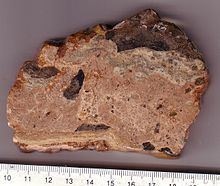 | ||
The 35–40 km-diameter Azuara impact structure is located in northeast Spain roughly 50 km south of Zaragoza. The name is attributed to the small town of Azuara located near the center of the structure. The first hint to a possible impact origin was given by Wolfgang Hammann as early as 1980, and the first field evidence was provided by Johannes Fiebag in the early eighties. In 1985, Ernstson et al. published the occurrence of shock metamorphism, and Azuara was established (Grieve & Shoemaker 1994, Hodge 1994, Norton 2002 as an authentic impact structure. From stratigraphic considerations and paleontological dating, its age is estimated to be Upper Eocene or Oligocene (roughly 30 - 40 Mill. years old).
Contents
The Azuara structure exhibits a roughly circular morphology implying a partly pronounced outer ring. The inner part is covered by post-impact Upper Cenozoic sediments, however in the outer rim zone, the outcrop conditions are excellent.
Impact features
The impact nature is documented by abundant polymictic and monomictic breccias, breccia dikes, extensive megabreccias and impact ejecta, dislocated megablocks, geophysical anomalies and shock metamorphism. Shock effects like melt glass, diaplectic glass, planar deformation features (PDFs) are found in breccias and breccia dikes, and PDFs are abundant also in quartzite clasts contributing to the ejecta (Pelarda Formation).
Shock metamorphism in the Azuara impact structure include planar deformation features in quartz. The histogram displays frequencies of crystallographically controlled planes of microdeformation. The {1013} and {1012} occurrences are especially diagnostic and are generally considered as in proof of impact shock.
Controversy
Like many other impact structures in the world, such as Nördlinger Ries, the Vredefort crater, or the Sudbury Basin, the origin of the Azuara structure has been debated, and Spanish geologists still remain opposed to an impact origin. In their opinion the shock effects are tectonic features, the impact ejecta (Pelarda Formation) are Quaternary alluvial fans and impact breccias and dike breccias are interpreted as karst features and soil formations.
The opposition against the impact origin for Azuara has been supported by an analysis and paper (Langenhorst & Deutsch 1996) denying the occurrence of shock metamorphism in Azuara rocks. Based on this paper and analysis, Azuara was removed from the Canadian Impact Data Base when its management changed to the University of New Brunswick. Azuara is still listed as a confirmed impact structure in other data bases, e.g. Moilanen, J., 2009 and the Expert Database on Earth Impact Structures (EDEIS).
Companion impact structures
Since 1994 it has been hypothesized that Azuara is only part of a much larger multiple impact event (Azuara impact event), comprising also an elongated impact basin suggested to have resulted from the impact of a string of impactors. This Rubielos de la Cérida basin bears all evidence of impact features like morphological signature, polymictic and monomictic breccias, megabreccias, ejecta deposits, shock metamorphism, suevites and impact melt rocks.
